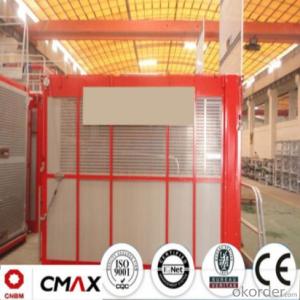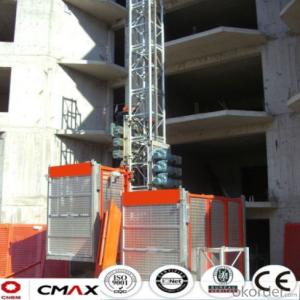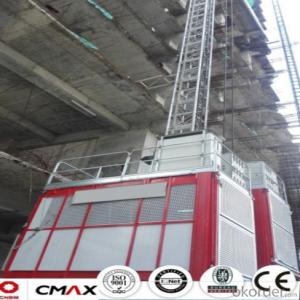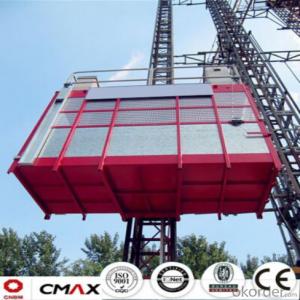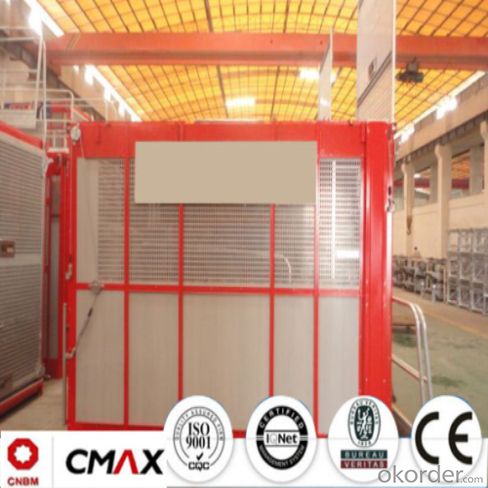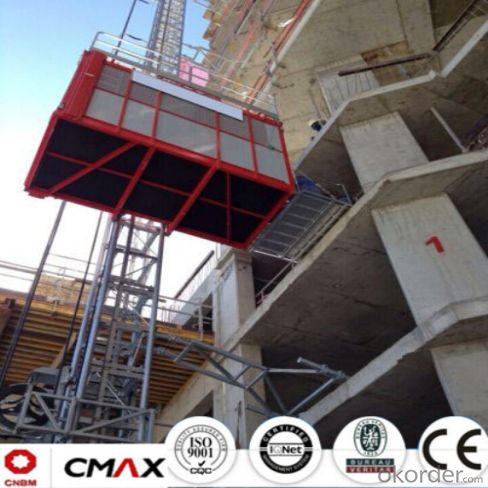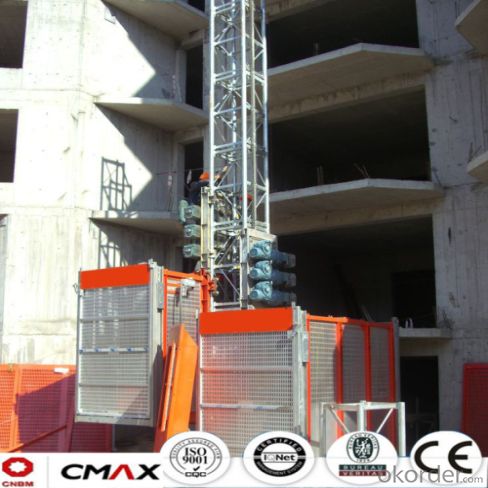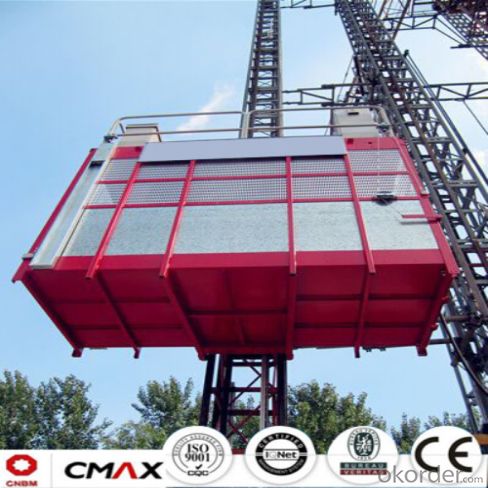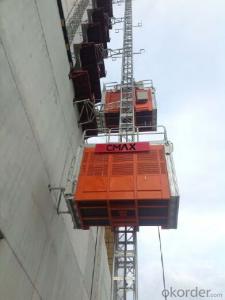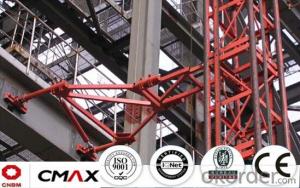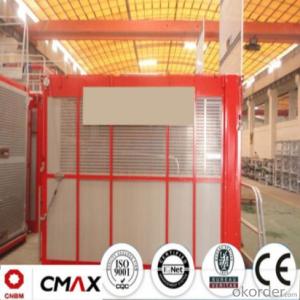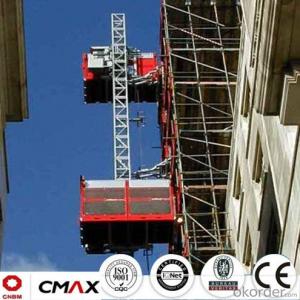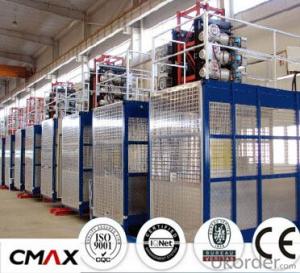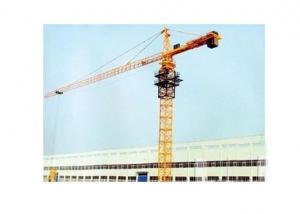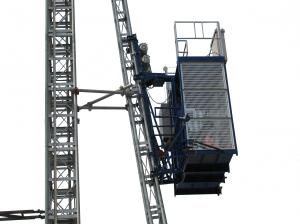Building Hoist Hot Galvanizing Mast Section with 2.4ton
- Loading Port:
- China main port
- Payment Terms:
- TT OR LC
- Min Order Qty:
- 1 unit
- Supply Capability:
- 5 unit/month
OKorder Service Pledge
OKorder Financial Service
You Might Also Like
Structure of Building Hoist Description
1.The gearing select perfect bearing,strong cables and oil seal.
2.The electrical parts select products from famous world manufacturers for example Schneider,Siemens and LG.
3.The racks and pinion select advanced material and advanced technique,which enhance the life of all parts.
4.The steel structure adopted strong steel from famous native manufacturers.
5.The surface of the steel structure can adopt paint-spray,parkerizing baking finish or hot galvanizing processing depending on users requirement.
6.The cage can be made and decorated by aluminum molded board,punched-plate or figured aluminum board.
Packaging & Delivery of Building Hoist
Packaging: nude and wooded box Delivery: 25-30days
Mains Parts of Building Hoist
1.The steel structure for example the mast, tie in and cabin ,could be all spay-painted and hot galvanized. Mast section is made with high quality Q345B which is the top standared in China.
2.Electrical parts are all adopted with Schneider , Siemens and other famous brands.
3.The electrical system can be selected with the normal control method and VVVF+PLC control way. Inverter we selected is from Schneider. Yaskawa or other world renowned brand.
4.Cabin exit door select ramping type. The ramping door looks like a bridge between the construction hoist and construction building.
5.The cabin floor is made from 3MM thickness steel riffled board(Hot dip galvanized), and 15MM thickness wooden board which can reduce the vibration and deformation a lot.
6.Driving unit is adopted the products from ZHANGJIANG and other reputed maker, or from SEW, NORD.
7.Safety system is mainly composed of electrical motor braking, anti-drop safety device, top & bottom limit switches, top & bottom 3-phase switches, door limit switches, buffer device and over-load protection. The system aims to ensure the hoist are running safely.
8.Qualification: CE, ISO9001:2008 and etc.
9.The long-term operation of CMAX building hoists testifies CMAX hoist is working performance is stable.
Building Hoist Images

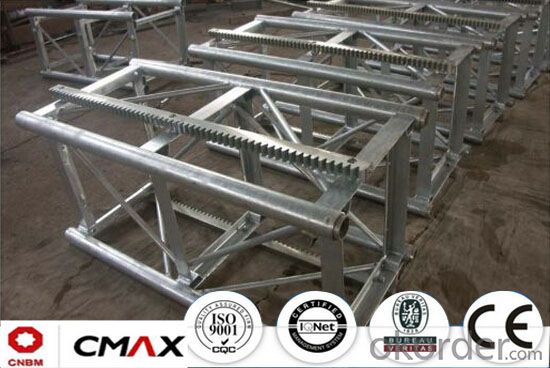
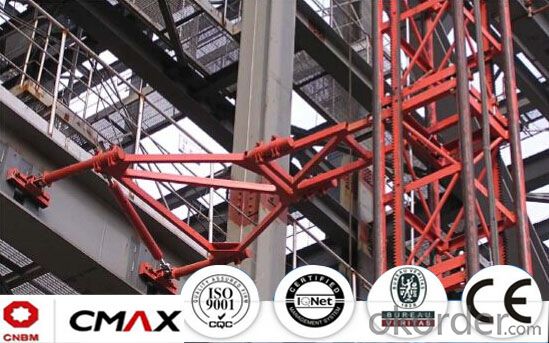
Building Hoist Specification
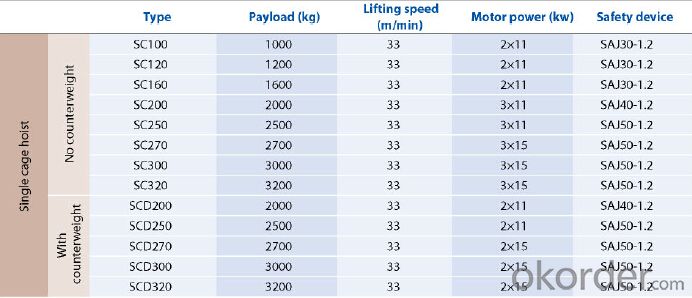
FAQ of Building Hosit
Q: What is the building hoist main purpose?
A: Building hoist equipped with double or single cabin to transport the materials and labors up and down. It's the ideal construction equipment for vertical transportation in the field of construction.
Q: What is the main structure of building hoist?
A: The P/M construction hoist mainly contains metal structure, driving system, electrical control system, cable guide & protection system, electrical top crane and safety device.
Q: What is the meaning of the building hoist’s code?
A: Take SC200/200 for example: “SC” stands for rack and pinion hoist, “200/200” stands for double cage and capacity is 2 tons per cage. “SC200” stands for single cage and capacity is 2 tons.
Q: What is the dimension of the cage?
A: Normally the cage dimension is 3X1.5X2.5M (L/W/H) for 2t type hoist. Details should be checked according to our
quotation sheet. Also, the size can be customized according to the factual site condition. There are two doors (entrance& exit doors) for each cage, It can be produced as up & down sliding or ramping model for safety and convenience.
- Q: What is the function or use of constructing a building hoist?
- <p>The purpose of building hoists is to facilitate the vertical transportation of materials, equipment, and sometimes personnel during the construction process. They are essential for moving heavy items to various floors or levels of a building under construction. Hoists enhance efficiency, reduce manual labor, and improve safety by minimizing the risk of accidents associated with manual handling of heavy loads. They are particularly crucial in high-rise construction where access is limited and the volume of materials to be moved is substantial.</p>
- Q: The working principle of construction elevator
- The construction elevator is a kind of common name, its standard name should be the construction elevator, this is a kind of crane machine equipment. Construction lifter adopts modular structure, because it is used in construction process, the elevator needs to be constantly shift with the construction project, therefore its structure must be easy to disassembly and assembly. For example, after the site is used, the elevator is disintegrated and transported to another site for reassembly of construction elevators. So how does the construction elevator work? The construction elevator mainly carries the structural self-forming system, and the construction dependence is low. It more driven by force, drive devices are installed on the hanging basket, through the gear and rack drive system, the mutual cooperation, so as to realize the rise and fall of the elevator. You may have seen gear and rack in the mechanical clock, the gear is round, the rack is straight, and the two bite together to achieve the motion. The elevator work that is common in our residential and commercial buildings is different from the construction elevator. Most of the elevator parts are fixed in buildings, which are mainly carried by buildings. Its movement is achieved through wire rope.
- Q: What are the benefits and drawbacks of utilizing a building hoist in construction?
- <p>Advantages of using a building hoist include increased efficiency in material transportation, reduced manual labor, and improved safety by minimizing the risk of accidents associated with manual handling. They can also speed up construction timelines by allowing for continuous material flow. Disadvantages include the initial cost of the hoist, the need for regular maintenance, and potential downtime in case of mechanical failure. Additionally, building hoists may have limited capacity and may not be suitable for all types of construction projects, especially those with irregular shapes or limited space for installation.</p>
- Q: How long does the construction elevator do a crash test
- For the safety of the crane, the anti-drop safety device must be certified every 1-2 years.
- Q: This question asks for methods to reduce the time a lifting device, such as a building hoist, is not operational and the expenses associated with its upkeep.
- <p>Minimizing downtime and maintenance costs for lifting equipment, including building hoists, involves a combination of proactive measures and regular maintenance. Implement a preventive maintenance schedule to address potential issues before they cause significant downtime. Use high-quality components to reduce the frequency of repairs. Train operators to handle equipment correctly and perform basic troubleshooting. Regularly inspect and lubricate moving parts to prevent wear and tear. Implement a condition monitoring system to detect early signs of malfunction. Finally, keep spare parts readily available to expedite repairs and minimize downtime.</p>
- Q: This question inquires about the cost of a hydraulic building hoist.
- <p>The cost of a hydraulic building hoist can vary significantly depending on factors such as capacity, brand, features, and new or used condition. Prices typically range from a few thousand dollars for smaller, basic models to tens of thousands for larger, more advanced units. For a precise quote, it's best to contact manufacturers or suppliers with specific requirements, as costs can fluctuate based on the model and market conditions. It's also advisable to consider ongoing maintenance and operational costs when budgeting for a hydraulic building hoist.</p>
- Q: This question asks for the method to determine the maximum weight a building hoist can lift.
- <p>The lifting capacity of a building hoist is calculated by considering several factors including the hoist's motor power, the strength of the hoist's construction materials, and the safety factor. The manufacturer usually provides the maximum lifting capacity based on these factors. To calculate it manually, you would need to know the motor's lifting force, the efficiency of the hoist's mechanical system, and apply a safety factor to ensure the hoist operates within safe limits. It's important to follow the manufacturer's guidelines and never exceed the specified lifting capacity to prevent accidents and ensure the hoist's longevity.</p>
- Q: Is it possible to replace an electric control panel with a manual lever in a lifting system?
- <p>While it is theoretically possible to use a manual lever as a substitute for an electric control panel in a lifting system, it is not advisable. Manual levers lack the precision, safety features, and control capabilities of electric control panels. They also cannot provide the same level of feedback or automation. Electric control panels are designed to ensure safe and efficient operation, with features like emergency stop buttons, overload protection, and remote monitoring. Manual levers can pose safety risks and may not meet the operational requirements of modern lifting systems.</p>
- Q: This question asks about the routine maintenance procedures for a building hoist, which is a piece of equipment used in construction to lift materials and personnel.
- <p>To maintain a building hoist, follow these steps: Regularly inspect the hoist for any signs of wear or damage, especially the cables, pulleys, and safety mechanisms. Lubricate moving parts as per the manufacturer's guidelines to reduce friction and prevent rust. Ensure all safety features, such as emergency stops and limit switches, are functioning correctly. Keep the hoist clean and free from debris, which can interfere with its operation. Check the electrical connections for any signs of corrosion or damage. Perform load tests to confirm the hoist's lifting capacity and ensure it meets safety standards. Always follow the manufacturer's maintenance schedule and guidelines, and have a professional service the hoist periodically.</p>
- Q: How to adjust the weight limit of the construction elevator
- You're talking about a weight monitor! There are a lot of models and not a good idea.
Send your message to us
Building Hoist Hot Galvanizing Mast Section with 2.4ton
- Loading Port:
- China main port
- Payment Terms:
- TT OR LC
- Min Order Qty:
- 1 unit
- Supply Capability:
- 5 unit/month
OKorder Service Pledge
OKorder Financial Service
Similar products
Hot products
Hot Searches
Related keywords
